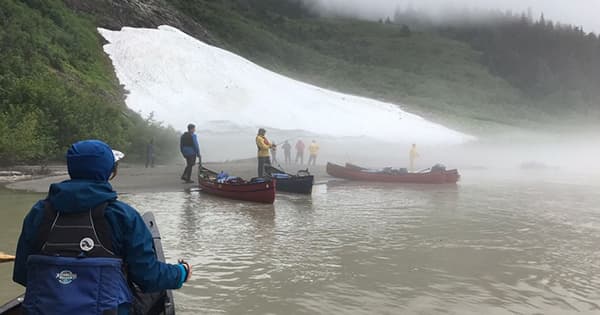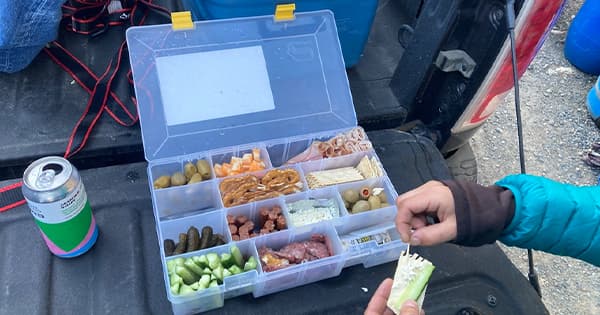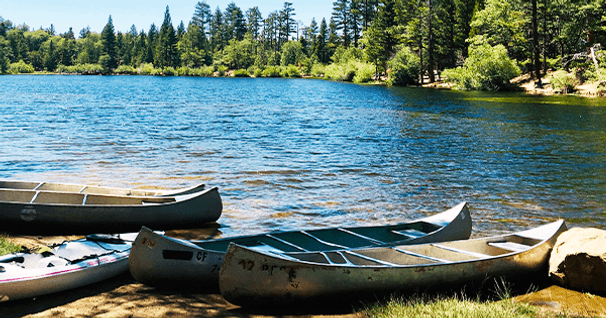Ontario Canoe-Trippers Head to Northern BC – Lessons Tripping North to the Lower Stikine
Every year we do a family and friends canoe trip. We usually tackle a river in Eastern Ontario or Western Quebec. By choosing rivers within a few hours of home, we generally know what to expect; sometimes it rains, the water is always warm, the bugs are always bad, and you can usually find birch bark to light a fire. This year, we decided to venture further from home. We wanted deep wilderness, continuous flow and mountain scenery. In order to make it affordable for our party of 10, we needed a river that did not require fly-in access. We did some research and discovered the Lower Stikine fit the bill.

Luckily we have some amazing friends who live in Whitehorse, YK and did not have to hire an outfitter. Drizz (now known as the Saint of Whitehorse) put us up at his place, gave us the skinny on tripping in the north, set us up with gear and drove us to the put-in. We learned a lot along the way…
1) Schedule time for logistical screw-ups:
To access the Lower Stikine River, first we had to get to Whitehorse. Four of us drove from Ontario with dehydrated food and a bunch of gear. The rest flew in from various places. From Whitehorse, we had a nine-hour drive to the put-in at Telegraph Creek. From there, ten days of paddling would bring us to Wrangell, Alaska, where we would board a ferry for the two day trip to Skagway and finally a two-hour drive would bring us back to Whitehorse for our return flights home.
After flight delays, Duke and his son arrived in Whitehorse the night before our planned 7:00am departure. They were the last of our crew to arrive and the airline had lost their luggage. By morning the airline still had no idea where their baggage was. Duke decided to start shopping for gear. After begging and borrowing everything he could, clearing out the local used outdoor shops, and a final run through the BigBox circuit, Duke and his son were outfitted and ready to go. We departed at 7:00 pm, drove through the night and arrived at Telegraph Creek to an amazing sunrise.
Because our stellar shuttle drivers were flexible and we had scheduled plenty of time on the river before our ferry departure, the trip was not negatively impacted. When travelling long distances with complicated logistics, much can go sideways. Vehicles overheat, get flat tires, or simply break on bumpy roads. When accessing a river by plane, weather delays are common. Always plan in some screw-up time, and if everything goes real smooth, it's just extra time in your hammock.
2) No Starbucks? – Tailgate coffee and the “Snacklebox”:

After arriving in Whitehorse and packing food for 10 days on the river, none of us felt like packing food for the road. We figured we’d just stop for fast-food or something along the way to the put-in. Because of the lost luggage fiasco, we ended up driving the 760km from Whitehorse to Telegraph Creek through the night. Regardless of the time of day, there was no fast-food on the route, and at night there was not even an open gas station.
Our drivers (Pope and Saint Dizz) knew what they were doing. We were able to buy gas with a card at the pump of a closed gas station, and we packed four jerry cans of gas – just in case.
A couple hours into the drive, we pulled off at a rest stop. Pope quickly pulled out his jetboil stove and all the fixings for coffee. In about as long as you would wait in line at a coffee shop, he had brewed up a pot on the tailgate of his truck for whoever wanted. If you didn’t want coffee, you could dip into the “cooler of fun” for fruit, cold water, sodas etc. At our final stop, Pope pulled out the piece de resistance, “the snackle box”, chacouteri-on-the-road. The man opened a tackle box filled with delectable treats. Smoked meats, various cheeses, olives, pickles, fruit, crackers all tucked neatly into their own little section but easily accessible by lifting one lid, genius!
Packing food, water and extra fuel is a must for a road trip like this. We would have survived. We had full water bottles to start the trip and plenty of snacks that we could dip into. But thanks to our drivers we rode in style and learned that travelling in the remote north means you can’t count on stores and other services – BYOEverything.
3) Its okay to get a late start
At the start of our trip in late July, dusk lasted from about 10pm till 2am then it got dark for a couple hours before dawn. It was like being in a time warp. Long hours of daylight coupled with the river flowing anywhere from 5-25km/h meant we had no reason to rush.
We had plenty of time to sleep in, cook big breakfasts, hike, fish and explore. We had the freedom to stop and check out cool things along the way without being concerned about arriving at camp after dark. We were spoiled with beautiful campsites.
One evening we arrived at our intended camp spot, the weather was poor and it was lacking shelter and firewood. We decided to stop for dinner then paddle into the evening. The weather cleared and we stopped during the 3-hour sunset at a snowfield at the edge of the river, still melting from where an avalanche had piled it last winter. Being flexible with our timing allowed us to experience a magical evening on the river.
Long daylight hours and the ability to cover distance quickly if needed enabled much flexibility in itinerary, stopping for a few hours or a day and making it up later was no big deal.
4) Strong current and headwinds - Loading bow heavy
I usually load my canoe a little stern heavy. I find having the bow high makes for a dryer ride through waves and makes it easier to turn the boat. For the first few days, my stern-heavy strategy served me well. By the third day of the trip we were experiencing pretty consistent, strong headwinds and with the powerful current it became extremely difficult to keep my canoe pointed downstream.
I have experienced difficulty with the bow high in heavy wind especially when soloing an unloaded canoe, but this was different. The river was fast and because of the headwind it was difficult to keep the canoe moving faster than the current. With the stern of my canoe deepest in the water it was pushed faster than the rest of my boat constantly turning me sideways. Once on an angle, the headwind would push as well making it near impossible to point the boat in the direction of the current.
Two solutions: If you're not in a hurry go with the flow, in our case the current was so strong that we were still moving 5-10km/h just floating sideways in a 25km/h headwind. When the wind got real bad we would just raft up and float. If you need to make miles fast, load the boat so it sits as flat as possible in the water, or even a little bow heavy if you can avoid the waves, or have a deck.
5) Dutch Oven Cooking – just do it
Since we would be on the river twice as long as our usual canoe trips we needed to get creative with food. I had some experience cooking with Dutch ovens on longer canoe trips 20 years ago and remembered it being amazing. And so, my love for he Dutch oven was rekindled.
We baked Shepard’s pie, lasagne, frittata, muffins, brownies, and the list goes on. The best part about cooking in a Dutch oven is that you do some prep, put the food in and sit back and relax until it's ready. You can get them in various sizes and stack them to cook multiple things at once like dinner and dessert, or bread for the next day’s lunch.
From now on, I will be bringing my Dutch oven on all trips, short or long. Not only do you have an oven, you have a cast iron skillet for frying, a spot to keep food warm, and, in a pinch, something heavy to throw at a bear.
6) Big braided rivers make new channels
On day 6 we woke to rain and wind, we set out on a mission to find the Chief Shakes Hot Springs. They were labelled on our map about 7 km off the Stikine river down a side channel and up a small creek. We did not know what to expect but even a warm mud hole would have been welcomed.
The wind, rain and low clouds made navigation difficult. Folks were cold and wet; we watched the map carefully so as not to miss the channel. When we finally entered the side channel, protected from the wind and getting close, group morale rose. After 10 minutes of paddling, the channel we were in brought us back to the main river. I almost cried. If we missed the channel we missed the hot springs that we had been looking forward to for days. We regrouped, some of us were optimistic that the channel was still ahead, others were in despair. We carried on, 200m downriver we found the channel and eventually the hot springs – pure bliss.
Once we were warm and dry, looking back we realised that the first channel we had been on did not exist on the map. The river had carved a new channel in the 3km wide valley and created an island with 50-year-old trees on it. For the remainder of the trip, we ensured that we relied on more information than the braiding channels to orient ourselves on the map.

Going on a canoe trip far from home, in a totally different ecosystem than we are used to, was a chance and experience of a lifetime. We learned a lot about travelling in the north and tripping on a big mountain river. Leave time for logistical screw-ups, be self-sufficient on long drives, take your time on the river, load your boat strategically for the current conditions, eat good food and don’t count on river channels as your only means of orienting yourself on a map. I took away many new tricks for my tripping toolbox, but most importantly I connected with the place, my amazing comrades and myself.
Inspired by wanderlust and a passion for rivers, Adrian's paddling addiction has taken him across the globe. After pursuing his degree in Outdoor Recreation and Tourism Management, Adrian eventually settled in Palmer Rapids, Ontario. Here, he has worked for over a decade as the Director Of Operations at The Boundless School.
Related Articles
Remember when you bought your first car? Or maybe it was a bike. You may have chosen it for its color,…
The key to tandem canoeing is to understand your role at whichever end of the boat you are paddling in.…
Before I was domesticated, I spent more than a decade working paddling gigs between paddling trips.…
A frame grab from Sally Wallick’s video camera captures her rescue of a struggling and hypothermic…



